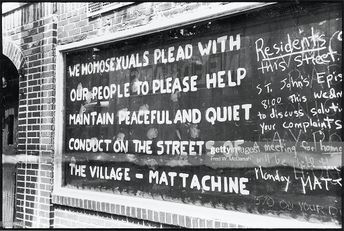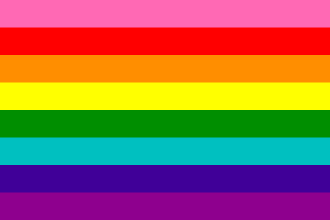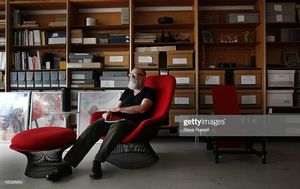GRSJ224/LGBTQ+ in Art
Turing points and Artifacts of History of LGBTQ+

The history of LGBTQ+ Pride were mostly tied to the events that occur in the United States which undoubtably has a strong influence over Canada's own rich history and turning points in fighting for the liberation of LGBT rights. Often the first things that comes to mind would be the infamous Stonewall Riots, Rainbow Flags, and Pride Parades.
Important Events/Works that Influenced Pride
Stonewall Riot, June 27 - July 2, 1969

The stonewall riot took place in the neighborhood of Central Greenwich Village of Lower Manhattan, New York. The riots which lasted five days were the product of decades of contempt against authorities and the general public that had mistreated the gay members of New York City. Even though, the Stonewall Riots were not the first movements against homosexual oppression, it motivated gays and lesbians in pursuing equal rights. The Stonewall Riot could be seen as the start of modern gay liberation movement in North America, and it influenced spreading on a global scale including Canada's own Pride Movement.
The Creation of the Rainbow Flag, 1978
The Rainbow Flag that symbolizes gay and lesbian communities pride was first created by Gilbert Baker. The flag was designed as a response to local activist's need for a community symbol. Baker initially designed the flag with eight colored strips: pink, red, orange, yellow, green, blue, indigo, and violet. Each color represented, sexuality, life, healing, sun, nature, art, harmony, and spirit respectively. The multicolor was also a representation of diversity of the community. However, due to manufacturing issues, the eight colored rainbow had been reduced to seven excluding the color pink for mass production. Prior to mass production, the first two rainbow flags created were hand dyed and sewn personally by Baker. [1]

The flag is different from other forms of art. It is neither a painting nor just a piece of cloth. It is a symbol which functions in many different ways. A symbol that is understood upon contact. The rainbow flag does not display the word "gay", but everyone knows what it represents. A flag is a statement that proclaims the community's visibility, or indirectly stating, "This is who I am.". The same rainbow flag is now a symbol associated with all LGBT+ members globally. The rainbow flag's significants does not lie in its individual colors but the symbolism as a single unit.[2]
Outrageous! the first Queer Canadian film to enter mainstream theatre, 1977
The Comedy film directed and written by Richard Benner, starts Craig Russel as Robin Turner and Hollis McLaren as Liza Conner, a schizophrenic roommate to Turner. The film was based on the short story written by Margaret Gibson The Butterfly Ward. Outrageous! importance to Canada's queer history was because it was one of the first ever gay-themed films to received widespread release in North America. Due to popularity, the film subsequently released a sequel Too Outrageous! in 1987. The film narrates the story of a gay hairdresser (Craig Russel) who hates his job living with his schizophrenic friend (Hollis McLaren). After Connors convinces Turner to attend a drag ball dressed as a woman. Turner felt liberated and further accepts a local club offer to work as a female impersonator. The film depicted heavy themes of gay liberation or even transexual liberation to a certain degree. The idea of 'coming out of the closet' could be seen as an inspiration for viewers of similar situations.[3]
LGBTQ+ Art Influences
Punk
The Punk movement played an important role for LGBTQ+ artist in music, fashion, art, and literature works. The Punk culture mostly associates with music influence from the 1970s. However, we still see punk influences in artwork through themes like sex industry, sex trade, gender identity, BDSM.
Queer Punk Movement of America
The Punk movement originates from the 1970s, with the likes of Patti Smith and Iggy Pop. The original movement were about going against everything America wanted to move towards. They embraced gender-fluid, feminist, and queer ideologies through music, fashion, and art. Punk was an anti-commercial movement that related more towards the sex industry. Since Most LGBTQ+ people were working in the sex trade during the 1970s.[4]
Queercore
This same ideology has been employed by Queercore, a Toronto based social and cultural movement. It started as a subculture of Punk, repressed by society's disapproval of homosexual activities and expressed through hardcore music, zines and movies. However, Queercore soon turned into its own movement and spread into music, art, film and literature. Queercore was the first cultural movement which includes queer identified people who participated in all sorts of media. There was not a movement prior to Queercore to have done it. The early artists spread awareness through zines and films which were inspired by the Dada Movement, Sex Pistols, etc.[5]
Notable Queercore Groups and Zines
- Limp Wrist - Fronted by Openly Gay Martin Sorrondeguy.
- Fifth Column - All female post punk band from Toronto
- Homopunk World #1, 1997 - Created by anonymous boy
Feminism Movement
The Feminism movement could be categorized into four movements based on chronology.
The First Feminism Movement in Canada has been a struggle to strive for equal rights. Early activism concentrated on increasing the role of women in public life such as, increase in property rights, access to education, and to be recognized under the law. The idea was based on the logic of maternal feminism; the notion that women are caregivers of the nation and should be able to participate in public life because their decisions made will have a positive impact on society.
The Second Movement took place during the Great Depression and World War II. The role of women in the workforce due to war brought about a new consciousness with regards to women's place in society. This has led to new campaigns striving for more equal rights focusing on the importance of equal pay for equal work, violence against women, and women's reproductive rights
The Third Movement started in the early 1990s. This movement were more concern over anti-racism, anti-colonialism, and anti-capitalism. The Third Movement were associated with mostly grassroots organizing opposed to the feminist organizations on a national level present in the second movement.
The Last Movement was sparked due to the resurgence of interest in feminism. The birth of social media or technology has further challenged misogyny and gender equalities. Thus, the movement focuses on sexual harassment and violence against women, including rap culture, campus sexual assault and workplace harassment.
The Feminist movement influenced artist to include political differences women and other gender identities might face. The hope is to bring positive change which strives for change in equality. Through the medium of art, we see how important topics revolving around Feminism ideas are being conveyed.[6]
Feminist Art
- Karin Lee: QueerSum 心,Small Pleasures, Short film - The exhibition by Karin Lee serves to investigate the role of women and examine racism through paying tribute to Vancouver's Chinatown. In particular, the work Small Pleasures examine the story of three women from different backgrounds explaining ideas on feministic resistance through a common language: Chinook Jargon. The film shows how marginalized women create individual identities that conform to the needs of a patriarchal society. [7]
- Desire Change: Contemporary Feminist Art in Canada - The book Desire Change edited by Heather Davis explores the colonial framework of exclusion and hierarchical devaluation which resulted in silencing the voices of women. The book takes stock of contemporary feminist cultural production, and bring together essays to discuss the production of political thought. The book that complied various feminist artworks was highly influenced by the Feminism Movement.[8]
The AIDS Crisis
The AIDS Crisis often referred to as the "Gay Plague". When AIDS epidemic first occured in the 1970s and '80s, there were tales that it only affected white gay males. In the beginning of the crisis, gay men and other men who have sex with men were often been accused for the transmission of AIDS. Due to the wild fire of media, homophobia within the public has been spreading increasingly. As a result, the LGBTQ+ community had been demonized. Bans and laws quickly follow such as, the criminalization of same-sex relationships, cross-dressing, sodomy, and gender impersonation. This stereotype and stigmatization had led to LGBTQ+ people being ostracized. The AIDS Crisis has created a certain stereotypes and stigma revolving around LGBTQ+ communities which still exist today.[9]

The General Idea
The General Idea is a artist group consisting of AA Bronson, Felix Partz, and Jorge Zontal. During their active years in 1987 to 1994, the group's work seek to addressed the AIDS crisis extensively. Mostly through humor and mimicry, the group promoted gay pleasures and showed the agony of AIDS in their exhibitions. Unfortunately, two of the artist in the collective had lost their life to AIDS. Leaving AA Bronson, who is still active in Printed Matters.[10]
Some of notable works from General Idea,
- Broken Time, an installation of repeated giant pills of AZT, a drug that was used to treat AIDS. the visualization seek to depict the pain of AIDS infected people in hopes of lessing the deadly effect of the illness,
- AIDS Paintings and IMAGEVIRUS - the first AIDS painting was an appropriation of Robert Indiana's LOVE logo, substituting the word 'LOVE' with 'AIDS'. The logo played an important part in creating awareness through appropriation and mimicry. The work was significant during a period of fear and misinformation surrounding the disease.[10]
Notable LGBTQ+ Canadian Artist
- Vivek Shraya – Toronto based artist whose work crossed disciplines of music, literature, visual art, and film. A Polaris Music Prize nominee and four-time Lambda Literary Awards finalist, Vivek is one of Canada's up and coming queer artist to look out for.
- Evergon - The Ontario-born Albert Jay Lunt aka Evergon seen tremendous success in his 35 year career as an instructor and artist. His works focuses on gay male culture, often concerned with technology of the past and present. Through out his career, Lunt has challenge the notions of "the norm". A Bookless Novel, stresses the need for queer-based artists. He creates moving desire for the male body and have played a vital role in queer definitions.

- AA Bronson - One of the three artists of General Idea, AA Bronson is currently based in Toronto and Berlin. When his partners died in 1994, AA exhibited as a solo artist, often collaborating with upcoming younger artist. From 2004-2010 he headed Printer Matter, Inc the company wo founded the annual NY Art Book Fair in 2005. AA Bronson as an artist is based on collaboration and consensus.
- Terence Koh - Koh's work includes drawing, sculpture, performance art, and the internet. Working under the alias "asianpunkboy", Koh produced various queer zines and books. His diverse work have been exhibited widely around the United States and abroad. He creates space in which memory and imagination mix with subculture; punk in particular. He often explores subjects like power, fashion, sexuality, religion, and mythology. He is most known for his monochromatic style in installation and ritual-like performances.
Resources
- QZAP: Zines Archive - An archive of queer zines created to preserve queer related zines and make them available for other queers, researchers, historians, punks, and anyone else.
- Queer art - A non-profit art organization serving the board spectrum of LGBTQ+ artist across generations and disciplines.
- Queer Arts Festival - An annual artist-led organization who host professional multidisciplinary arts festival in Vancouver, BC.
- Davie Village - An informative website on Vancouver's history gay neighborhood. The website provides information for gay-friendly events, gay businesses and gay news. In addition, the concise history of LGBTQ in Canada.
References
- ↑ Pinette, Christopher (12 June 1996). "Eight Striped Version". FOTW Flags of the World website.
- ↑ Antonelli, Paola (17 June 2015). "MoMA Acquires the Rainbow Flag". Inside Out.
- ↑ "Outrageous! (1977)". IMDb. 31 July 1977.
- ↑ O'Connor, Alan (2002). "Local Scenes and Dangerous Crossroads: Punk and Theories of Cultural Hybridity". Popular Music 21. 2: 229–230 – via http://www.jstor.org.ezproxy.library.ubc.ca/stable/853684.
- ↑ Farber, Jim (20 September 2018). "Queercore: behind a documentary reliving the gay punk movement". The Guardian. Archived from the original on
|archive-url=requires|archive-date=(help). - ↑ Hewitt, Nancy A. (FALL 2012). "Feminist Frequencies: Regenerating the Wave Metaphor". Feminist Studies. Vol. 38, No. 3: 658–680 – via https://www-jstor-org.ezproxy.library.ubc.ca/stable/23720198. Check date values in:
|date=(help) - ↑ "Karin Lee: QueerSum 心". Queer Arts Festival. Archived from the original on
|archive-url=requires|archive-date=(help). Retrieved 19 February 2019. - ↑ Frappier, Valerie (30 November 2017). "Making a Case for 21st-Century Feminist Art". Canadian Art. Archived from the original on
|archive-url=requires|archive-date=(help). Retrieved 19 Feburary 2019. Check date values in:|access-date=(help) - ↑ Brier, Jennifer (2009). ""Affection Is Our Best Protection: Early AIDS Activism and the Legacy of Gay Liberation."". Infectious Ideas: U.S Political Responses to AIDS Crisis: 11–44 – via JSTOR.
- ↑ 10.0 10.1 Decter, Joshua (Spring/Summer 2007). "Infect the Public Domain with an Imagevirus: General Idea's AIDS Project". Afterall: A Journal of Art, Context and Enquiry. Issue 15: 96–105 – via https://www-jstor-org.ezproxy.library.ubc.ca/stable/20711645. Check date values in:
|date=(help)